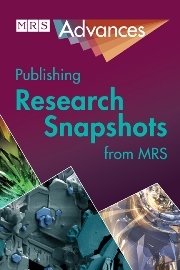No CrossRef data available.
Article contents
Hybrid Zero-Dimensional C60 clusters with Graphene – Synthesis, Fabrication and Transport Characteristics
Published online by Cambridge University Press: 15 June 2017
Abstract
In this work, a new method is presented to synthesize graphene-C60 hybrid materials using an electrophoretic deposition technique to study the graphene-C60 interactions. Electronic measurements of the structure were conducted before and after the attachment of C60 clusters at different applied voltages on graphene devices. The assembled clusters of C60 on mechanically exfoliated graphene were investigated using Raman Spectroscopy and Scanning Electron Microscopy (SEM), which reveal a uniform morphology of C60 on graphene. The results indicate that graphene-C60 hybrids are excellent electron accepting/charge transporting materials which can provide an effective route to facilitate the application of these hybrids in electronic or opto-electronic device platforms.
Keywords
- Type
- Articles
- Information
- Copyright
- Copyright © Materials Research Society 2017


